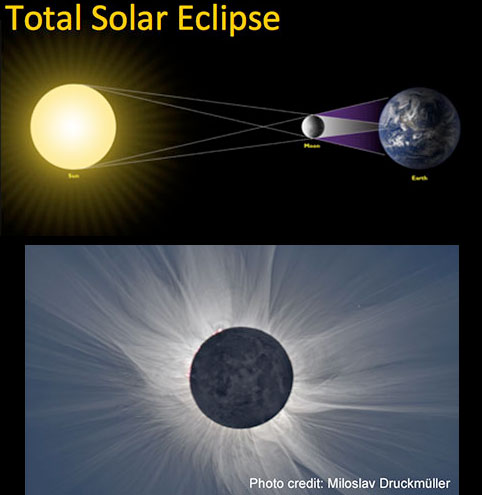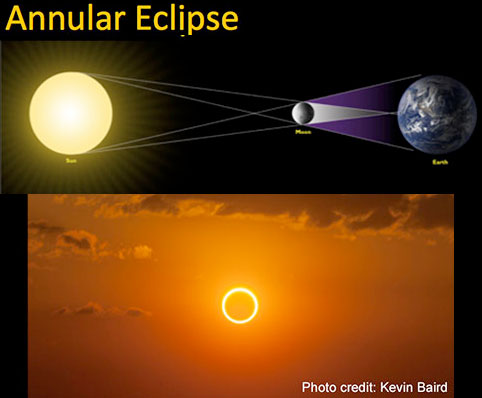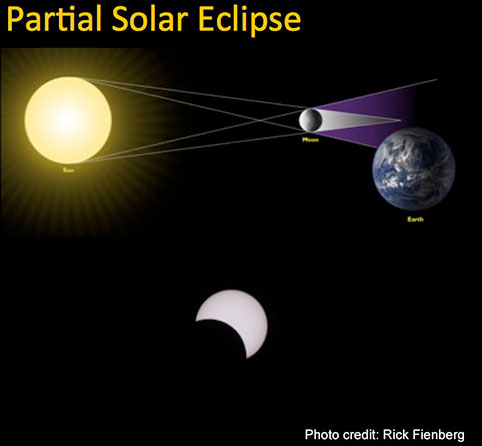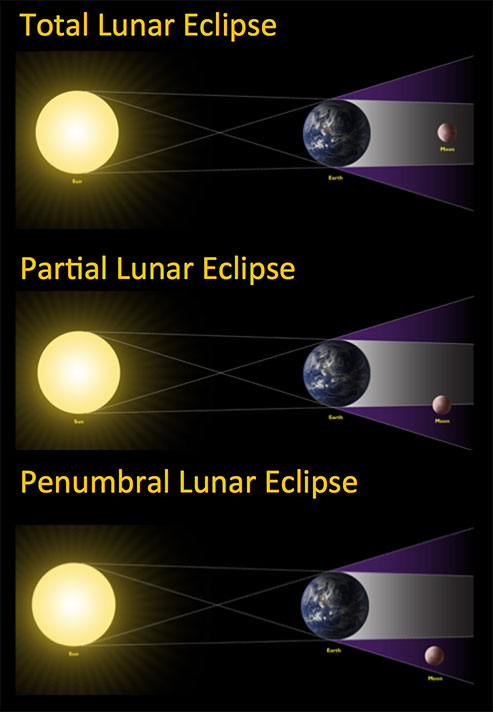The free Totality app was created by Big Kid Science, which subsequently donated the app to the American Astronomical Society (AAS).
For additional eclipse information beyond what you find within the Totality app, please visit the American Astronomical Society (AAS) Eclipse Pages (eclipse.aas.org).
The Totality app has built-in maps for a total solar eclipses through 2050. The first section takes you to these same eclipses on Xavier Jubier’s interactive web pages. Scroll down for info and dates for other types of eclipse (and learn about them at Understanding Eclipses).
Solar Eclipses
 Solar eclipses come in three types: total, annular, and partial. (“Hybrid” means the same eclipse path includes some regions where the eclipse will be total and others where it will be annular.)
Solar eclipses come in three types: total, annular, and partial. (“Hybrid” means the same eclipse path includes some regions where the eclipse will be total and others where it will be annular.)
Total Solar Eclipses, 2017 Through 2049
This first table lists recent and upcoming total solar eclipses through 2049, with links to either Xavier Jubier’s interactive maps or the TimeandDate.com site maps for each for each.
| Date of Eclipse | Maximum Length of Totality (min:sec) |
Major Locations Crossed by Path of Totality |
| Monday, August 21, 2017 | 2:40 | USA |
| Tuesday, July 2, 2019 | 4:28 | Chile, Argentina |
| Monday, December 14, 2020 | 4:33 | Chile, Argentina |
| Saturday, December 4, 2021 | 1:54 | Antarctica |
| Thursday, April 20, 2023 (hybrid) | 1:16 | Australia, Indonesia |
| Monday, April 8, 2024 | 4:28 | Mexico, USA |
| Wednesday, August 12, 2026 | 2:18 | Greenland, Iceland, Spain |
| Monday, August 2, 2027 | 6:23 | Spain, Northern Africa, Arabian Peninsula |
| Saturday, July 22, 2028 | 5:10 | South Africa, Australia |
| Monday, November 25, 2030 | 3:44 | Australia |
| Friday, November 14, 2031 (hybrid) | 1:08 | Pacific Ocean |
| Wednesday, March 30, 2033 | 2:37 | Alaska |
| Monday, March 20, 2034 | 4:09 | Nigeria, Chad, Sudan, Saudi Arabia, Iran, Afghanistan |
| Sunday, September 2, 2035 | 2:54 | China, North Korea, Japan |
| Monday, July 13, 2037 | 3:58 | Australia, New Zealand |
| Sunday, December 26, 2038 | 2:18 | Australia, New Zealand |
| Thursday, December 15, 2039 | 1:51 | Antarctica |
| Tuesday, April 30, 2041 | 1:51 | Africa: Angola, DRC, Rwanda, Burundi, Uganda, Kenya |
| Sunday, April 20, 2042 | 1:51 | Indonesia, Philippines |
| Thursday, April 9, 2043 | 1:51 | Russia |
| Tuesday, August 23, 2044 | 1:51 | Canada, USA (northern Montana & North Dakota only) |
| Saturday, August 12, 2045 | 1:51 | USA |
| Thursday, August 2, 2046 | 1:51 | Africa: Angola, Botswana, South Africa |
| Saturday, December 5, 2048 (hybrid) | 1:51 | Chile, Argentina |
| Thursday, November 25, 2049 (hybrid) | 1:51 | Saudi Arabia, Yemen, Indonesia |
Annular Solar Eclipses
 If a solar eclipse occurs when the Moon is relatively far from Earth in its orbit, its full shadow may not reach the Earth. In that case, locations directly behind the full shadow will see an annular eclipse, in which a ring of sunlight is still visible around the Sun at maximum eclipse. As a result, day does not turn into night like it does for a total solar eclipse, and there is never a time when you can look at an annular eclipse without eclipse glasses. The following table lists recent and upcoming annular solar eclipses through 2030, with links to Xavier Jubier’s interactive maps for each.
If a solar eclipse occurs when the Moon is relatively far from Earth in its orbit, its full shadow may not reach the Earth. In that case, locations directly behind the full shadow will see an annular eclipse, in which a ring of sunlight is still visible around the Sun at maximum eclipse. As a result, day does not turn into night like it does for a total solar eclipse, and there is never a time when you can look at an annular eclipse without eclipse glasses. The following table lists recent and upcoming annular solar eclipses through 2030, with links to Xavier Jubier’s interactive maps for each.
| Date of Eclipse | Major Locations Crossed by Path of Annularity |
| Saturday, October 14, 2023 | USA, Mexico, Central America, Colombia, Brazil |
| Wednesday, October 2, 2024 | Easter Island, Chile, Argentina |
| Tuesday, February 17, 2026 | Antarctica |
| Saturday, February 6, 2027 | Chile, Argentina |
| Wednesday, January 26, 2028 | Galapagos, Ecuador, Peru, Brazil, French Guiana |
| Saturday, June 1, 2030 | Greece, Turkey, Russia |
Partial Solar Eclipses
 During a total or annular eclipse, locations that are within the Moon’s partial shadow will see a partial solar eclipse. In addition, sometimes the Moon’s full shadow passes above or below the Earth, in which case there is no path of totality or annularity on Earth, so the eclipse is partial only. Xavier Jubier has a list and map links for recent and upcoming partial-only solar eclipses.
During a total or annular eclipse, locations that are within the Moon’s partial shadow will see a partial solar eclipse. In addition, sometimes the Moon’s full shadow passes above or below the Earth, in which case there is no path of totality or annularity on Earth, so the eclipse is partial only. Xavier Jubier has a list and map links for recent and upcoming partial-only solar eclipses.
Lunar Eclipses
Lunar eclipses are also worth watching. A lunar eclipse is generally visible to anyone on the night side of the world when it occurs. The following table lists recent and upcoming lunar eclipses through 2032, with links to maps showing where they can be seen from the Hermit Eclipse web site. The dates and times listed below are Universal Time (UT), also called Greenwich Mean Time (GMT) or Coordinated Universal Time (UTC), which you can convert to local time with web sites such as timeanddate.com.

| Date/Time (UT) | Type | Where You Can See It |
| 5 May, 2023 15:14–19:31 |
penumbral | Europe, Africa, Asia, Australia |
| 28 Oct, 2023 18:01–22:26 |
partial | Europe, Africa, Asia, Australia |
| 25 Mar, 2024 04:53–09:32 |
penumbral | Asia, Australia, Pacific, Americas, Atlantic |
| 18 Sep, 2024 00:41–04:47 |
partial | Americas, Europe, Africa |
| 14 Mar, 2025 03:57–10:00 |
total | Americas, western Africa |
| 7 Sep, 2025 15:28–20:55 |
total | Europe, Africa, Asia, Australia |
| 3 Mar, 2026 10:51–16:08 |
total | E. Asia, Australia, western N. America, Central America |
| 28 Aug, 2026 17:14–23:28 |
partial | Americas, W. Europe, Africa |
| 20 Feb, 2027 02:36–07:48 |
penumbral | eastern Americas, Europe, Africa, Asia |
| 18 July, 2027 18:43–00:17 |
penumbral | southeastern Africa, south Asia, Australia |
| 17 Aug, 2027 17:07–21:12 |
penumbral | eastern Australia, New Zealand, Polynesia, Americas |
| 12 Jan, 2028 17:45–21:04 |
partial | Americas, Europe, Africa |
| 6 July, 2028 03:07–05:52 |
partial | Africa, Asia, Australia |
| 31 Dec, 2028 07:32–11:53 |
total | Africa, Europe, Asia, Australia |
| 26 June, 2029 08:47–13:49 |
total | Americas, western Europe, Africa |
| 20 Dec, 2029 06:02–12:03 |
total | eastern Americas, Europe, Africa |
| 15 June, 2030 06:02–12:03 |
partial | Europe, Africa, Asia, Australia |
| 09 Dec, 2030 06:02–12:03 |
penumbral | Europe, Africa, Middle East, Asia |
| 31 May, 2031 06:02–12:03 |
penumbral | Americas, western Europe, Africa |
| 5 June, 2031 06:02–12:03 |
penumbral | Asia, Australia, New Zealand, western Americas |
| 30 Oct, 2031 06:02–12:03 |
penumbral | Americas, eastern Asia, Australia, western Europe and Africa |
| 25 Apr, 2032 06:02–12:03 |
total | east Asia, Australia, New Zealand and the Pacific |
| 18 Oct, 2032 06:02–12:03 |
total | Europe, Asia |
